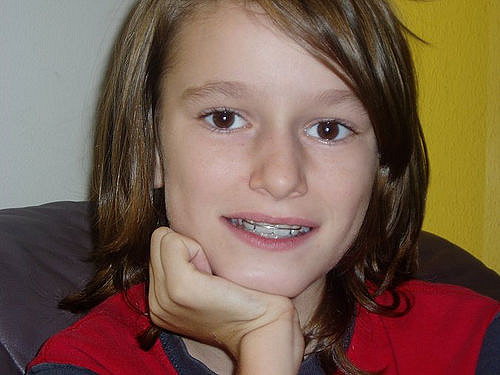Photo credit: Spring Dew via Foter.com / CC BY.
Patients may need post-orthodontic surgery, such as a fiberotomy or alternatively a gum lift, to prepare their teeth for retainer use and improve the gum line contours after the braces come off.
Retainers
Hawley retainers are the most common type of retainers. There are retainers for the top and bottom of the mouth.
In order to prevent the teeth from moving back to their original position, retainers are worn once the treatment is complete. Retainers help in maintaining and stabilizing the position of teeth long enough to permit reorganization of the supporting structures after the active phase of orthodontic therapy. If the patient does not wear the retainer appropriately and/or for the right amount of time, the teeth may move towards their previous position. For regular braces, Hawley retainers are used. They are made of metal hooks that surround the teeth and are enclosed by an acrylic plate shaped to fit the patient’s palate. For invisalign braces, an Essix retainer is used. This is similar to the regular invisalign braces; it is a clear plastic tray that is firmly fitted to the teeth, which stays in place without a plate fitted to the palate. There is also a bonded retainer where a wire is permanently bonded to the lingual side of the teeth, usually the lower teeth only. Doctors will sometimes refuse to remove this retainer, and a special orthodontic appointment to have it removed may be required.
Headgear
Headgear needs to be worn between 12–22 hours each day to be effective in correcting the overbite, typically for 12 to 18 months depending on the severity of the overbite, how much it is worn and what growth stage the patient is in. Typically the prescribed daily wear time will be between 14 and 16 hours a day and is frequently used post primary treatment phase to maintain the position of the jaw and arch.
Orthodontic headgear will usually consist of three major components:
Full orthodontic headgear with headcap, fitting straps, facebow and elastics
Facebow: First, the facebow (or J-Hooks) is fitted with a metal arch onto headgear tubes attached to the rear upper and lower molars. This facebow then extends out of the mouth and around the patients face. J-Hooks are different in that they hook into the patients mouth and attach directly to the brace.
Head cap: The second component is the headcap, which typically consists of one or a number of straps fitting around the patients head. This is attached with elastic bands or springs to the facebow. Additional straps and attachments are used to ensure comfort and safety.
Attachment: Tthe third and final component—typically consisting of rubber bands, elastics, or springs—joins the facebow or J-Hooks and the headcap together, providing the force to move the upper teeth, jaw backwards.
The headgear application is one of the most useful appliances available to the orthodontist when looking to correct a Class II malocclusion.
Pre-finisher
The pre-finisher is molded to the patient’s teeth by use of extreme pressure to the appliance by the person’s jaw. The product is then worn a certain amount of time with the user applying force to the appliance in their mouth for 10 to 15 seconds at a time. The goal of the process is to increase the exercise time in applying the force to the appliance. If a person’s teeth are not ready for a proper retainer the orthodontist may prescribe the use of a preformed finishing appliance such as the pre-finisher. This appliance fixes gaps between the teeth, small spaces between the upper and lower jaw, and other minor problems.
More information on: Wikipedia.




